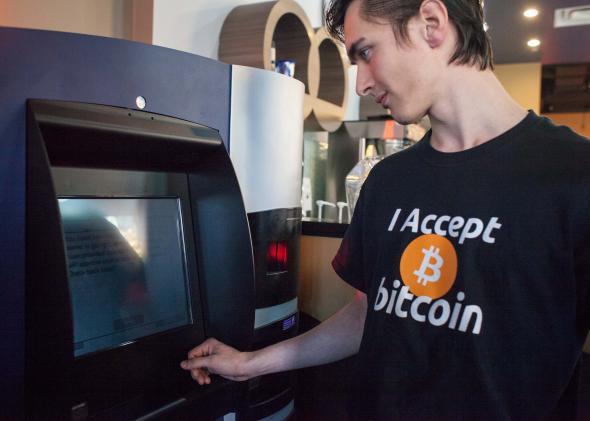There has been a lot of discussion over the last year about bitcoin, the non-state-backed digital currency introduced to the world in 2008 by a person (or group) identified as Satoshi Nakamoto. Advocates of making purchases using bitcoin point to its efficiency; detractors argue that the pseudonymous nature of the transactions makes it a magnet for criminals.
But bitcoin isn’t only a currency. It is also a protocol that makes it possible to perform digital transfers overseen and secured by the collective power of a network of widely dispersed computers. Today, the bitcoin protocol is used mostly to transfer bitcoins. But decentralized digital trust mechanisms, of which bitcoin is just the first widely adopted example, have the potential to do far more than that.
As Marc Andreessen wrote in the New York Times in January, “Bitcoin gives us, for the first time, a way for one Internet user to transfer a unique piece of digital property to another Internet user, such that the transfer is guaranteed to be safe and secure, everyone knows that the transfer has taken place, and nobody can challenge the legitimacy of the transfer.” Even journalist Glenn Fleishman, who has a skeptical view of bitcoin as a currency, acknowledges that the bitcoin protocol “is the first practical, large-scale mechanism to deal with the problem of decentralizing trust—no parties need know each other nor trust each other for transactions to complete successfully, verifiably, and irrevocably.”
So what might this have to do with copyright? A lot. One of the central challenges of copyright in the digital era lies in providing consumers with access to content while simultaneously preventing the proliferation of unauthorized copies. Solutions for managing digital rights are closely tied to trust—who has it, who doesn’t, and how it can be ensured. Much of today’s digital infrastructure, including an increasing fraction of the infrastructure for content distribution, is built on the assumption that trust needs to be centralized to be enforceable. And that is the assumption that the bitcoin protocol has proven false.
The consolidation of content and of trust mechanisms for accessing it has accelerated in the last several years with the move to the cloud. Increasingly, content providers are offering to store your content for you. Apple, for instance, promotes iCloud as a way to “[a]ccess your content on all your devices. … Whether you have one Apple device or five, iCloud takes care of everything. And you barely have to do a thing.”
In part, solutions like iCloud are rooted in a genuine desire to provide consumers with a more convenient way to engage with their content. But these centralized content management offerings are attractive to content providers for less altruistic reasons as well: They can create a disincentive for consumers to purchase content elsewhere. Over the long term this could reduce the number of access options available to consumers. In addition, centralized systems turn consumers into ongoing sources of marketing data that can be harvested to boost future sales within a provider’s own ecosystem.
Against this backdrop, using decentralized trust mechanisms to help address digital rights management is genuinely intriguing. This wouldn’t require any change to copyright law. And it wouldn’t mean a wholesale replacement of current techniques for getting content to consumers. It just means that content creators and providers would have an additional technology option at their disposal when choosing how to structure licenses and manage distribution.
Decentralized trust would make it easy for independent artists to elect to offer songs under a new class of license that could let a purchaser resell the license after a few weeks or months, while also freeing artists from the burden of building and administering the systems to manage those transfers. Decentralized trust could also be used to build a secure, globally accessible, opt-in database that would make it easier to locate and pay royalties to artists who might otherwise go unpaid.
And, a decentralized playback system could put a layer between consumers and cloud-based content services, giving consumers increased flexibility and privacy. Information necessary to ensure proper handling of digital rights could pass freely through this layer, while other information could be partially anonymized—for instance, your ZIP code, but not your IP address, could be given to the content provider. After all, if you have purchased a license allowing you to listen to a song stored in the cloud from any location in the United States, there is no copyright law requirement that the cloud service provider needs to know exactly which house you are in when you choose to do so. Decentralized playback could also make it easier to stream the song from multiple content providers—not just the one you licensed it from.
Of course, most content providers would like to maintain as much control as possible and to gather all the information they can about content consumption habits. But if there is consumer demand for more flexible, privacy-enhancing, copyright-respecting ways of enabling cloud-based content access, the technology of decentralized trust can be used to build solutions.
Today, it seems hard to imagine that copyright protection and content access might someday be managed in part through decentralized trust networks based on bitcoin-like protocols. But 10 years ago very few people talked about storing media “in the cloud.” Ten years before that storing digital media anywhere at all was still a challenge.
The past few years of experience with bitcoin have proven what many people would have previously thought impossible: Trust in digital assets can be effectively and reliably managed in a decentralized manner. Sooner or later, more sophisticated derivatives of the bitcoin protocol are certain to have an impact on how we distribute and manage content.
